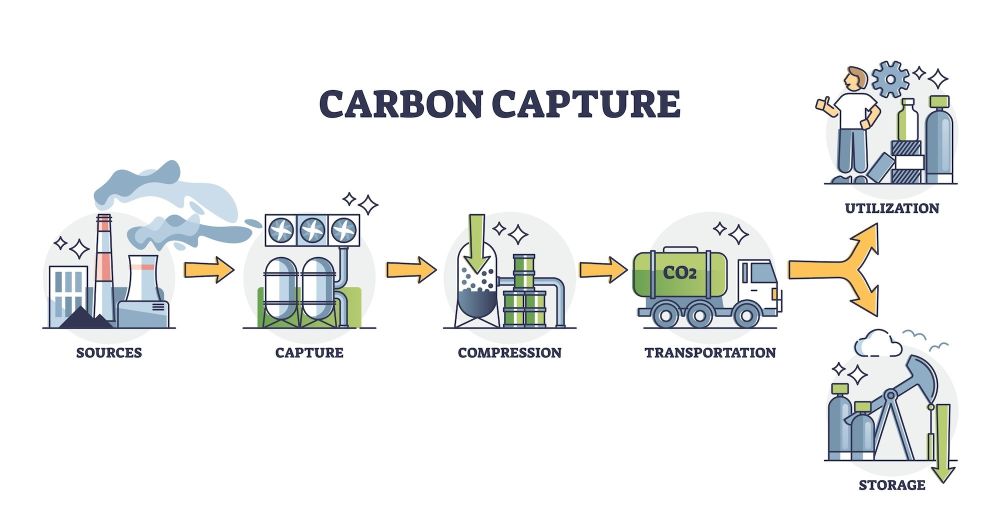
Climeworks: Carbon Removal with Innovative Direct Air Capture Technology

Summary
Cut through the green tape
We don't push agendas. At Net Zero Compare, we cut through the hype and fear to deliver the straightforward facts you need for making informed decisions on green products and services. Whether motivated by compliance, customer demands, or a real passion for the environment, you’re welcome here. We provide reliable information—why you seek it is not our concern.
Details
Deep dive
Climeworks is a company that commercializes a highly energy-efficient technology for capturing CO2 directly from the air. This direct air capture (DAC) technology is designed to remove carbon dioxide from the atmosphere and can play a crucial role in addressing climate change by reducing the overall concentration of greenhouse gases. Climeworks aims to inspire and empower people to combat climate change by permanently removing CO2 from the atmosphere. Their core purpose is to provide a scalable solution for carbon removal, contributing significantly to global carbon reduction efforts.
Did you know that Climeworks' technology has the potential to capture up to 4,000 tons of CO2 annually per facility? This innovative approach not only helps in reducing greenhouse gas concentrations but also paves the way for achieving carbon neutrality on a global scale.
Source: YaleEnvironment360
Company Background
Climeworks was founded in 2009 by engineers Christoph Gebald and Jan Wurzbacher, who envisioned leveraging technology to combat climate change. The company started with research and development in direct air capture (DAC) technology. A significant milestone was achieved in 2017 when Climeworks opened the world’s first commercial DAC plant in Hinwil, Switzerland. Since then, the company has expanded its operations, establishing several plants across Europe and forming strategic partnerships to scale their technology.
Founders and Key Figures:
Christoph Gebald and Jan Wurzbacher are the co-founders of Climeworks. Both hold degrees in mechanical engineering from ETH Zurich and have extensive backgrounds in engineering and climate solutions.
Christoph Gebald serves as Co-CEO and has a deep passion for developing sustainable technologies.
Jan Wurzbacher, also Co-CEO, brings his expertise in mechanical engineering and business development to drive the company’s growth.
Dominik Bachmann, Chief Operating Officer, oversees the operational aspects of the company, ensuring efficient and effective implementation of their technologies.
Funding and Investors: Climeworks has successfully secured funding through various rounds to support its growth and technological advancements. In recent years, the company has attracted major investors, including Partners Group, Swiss Re, and venture capital firms such as Breakthrough Energy Ventures and Global Founders Capital. Notable funding rounds include a significant $100 million investment in 2021, which has been instrumental in scaling up their CO2 capture capacity and expanding their global footprint.
Products and Services
Core Products/Services:
Direct Air Capture (DAC) Technology: Climeworks' primary service is their state-of-the-art direct air capture technology, which efficiently removes CO2 directly from the atmosphere. This technology uses a filter to capture carbon dioxide, which is then either stored underground or utilized in various applications. By removing CO2 from the air, Climeworks contributes directly to reducing greenhouse gas concentrations, playing a critical role in global efforts to mitigate climate change.
Carbon Dioxide Removal as a Service: Climeworks offers a subscription-based service for individuals and companies to offset their carbon footprints. Subscribers can choose plans that correspond to the amount of CO2 they wish to remove, effectively enabling them to neutralize their emissions. This service provides a practical solution for businesses aiming to meet sustainability goals and for individuals committed to reducing their personal carbon impact.
Partnerships for Carbon Utilization: Climeworks collaborates with various industries to utilize captured CO2 in innovative ways. For instance, captured CO2 can be used in the production of carbon-neutral fuels, beverages, and materials. These partnerships help close the carbon loop, ensuring that the captured CO2 is repurposed, further contributing to sustainability efforts.
Permanent CO2 Storage: In addition to utilization, Climeworks focuses on the permanent storage of CO2 through geological sequestration. By injecting captured CO2 into underground rock formations, the company ensures that the carbon is safely and permanently stored, preventing it from re-entering the atmosphere. This approach is essential for achieving long-term climate goals and maintaining a stable climate system.
Innovative Technologies and Approaches:
Advanced Direct Air Capture (DAC) Units: Climeworks' DAC technology stands out due to its efficiency and scalability. The company employs modular DAC units that can be combined to scale up operations as needed. These units use a specially designed filter that captures CO2 when air is passed over it. Once saturated, the filter is heated, releasing the concentrated CO2 for storage or utilization. This cyclical process ensures continuous operation and efficient CO2 capture.
Energy-Efficient Processes: One of the critical innovations of Climeworks' technology is its energy efficiency. The DAC units are designed to minimize energy consumption by using low-temperature heat sources, which can be renewable or waste heat from industrial processes. This focus on energy efficiency reduces the overall carbon footprint of the capture process, making it a more sustainable solution.
Carbon Storage and Utilization: Climeworks is at the forefront of developing and implementing carbon storage solutions. The company collaborates with partners to permanently store captured CO2 underground, using geological sequestration methods. Additionally, Climeworks explores innovative ways to utilize captured CO2, such as converting it into renewable fuels, materials, and even enhancing agricultural processes through carbon-based fertilizers.
Continuous Monitoring and Verification: To ensure the effectiveness and transparency of their operations, Climeworks employs continuous monitoring and verification systems. These systems track the amount of CO2 captured, stored, or utilized, providing verifiable data to customers and stakeholders. This commitment to transparency helps build trust and demonstrates the tangible impact of their technology.
Collaborative Innovation: Climeworks actively collaborates with research institutions, industry partners, and government agencies to advance the field of carbon capture and storage (CCS). By participating in joint research projects and pilot programs, Climeworks not only improves its technology but also contributes to the broader understanding and acceptance of CCS as a critical tool in combating climate change.

Case Studies and Successful Implementations:
Hinwil, Switzerland – First Commercial DAC Plant: In 2017, Climeworks launched the world’s first commercial direct air capture plant in Hinwil, Switzerland. This facility captures CO2 from ambient air and supplies it to a nearby greenhouse to enhance vegetable growth. By using captured CO2 to boost agricultural productivity, this project not only demonstrates the practical application of DAC technology but also showcases a sustainable method of CO2 utilization.
Orca Plant in Iceland: In 2021, Climeworks inaugurated the Orca plant in Iceland, the largest DAC facility in the world at the time. Orca captures 4,000 tons of CO2 annually and stores it permanently underground using Carbfix’s geological storage method. This project highlights Climeworks’ ability to scale their technology and the successful integration of carbon capture with permanent storage solutions, providing a blueprint for future large-scale deployments.
Partnership with Carbfix: Climeworks collaborates with Carbfix, an Icelandic company specializing in carbon storage. At the Hellisheidi geothermal power plant, captured CO2 is injected into underground basalt rock formations, where it mineralizes and becomes a permanent part of the rock. This partnership exemplifies the effective combination of renewable energy and carbon capture and storage (CCS) technologies to achieve negative emissions.
Audi Partnership for Carbon Neutrality: Climeworks has partnered with Audi to help the automotive manufacturer achieve its carbon neutrality goals. Through this collaboration, Climeworks captures CO2 from the atmosphere, which Audi then uses to produce synthetic fuels. This initiative demonstrates how Climeworks’ technology can support industries in reducing their carbon footprints and transitioning to more sustainable practices.
Swiss Re – Corporate Carbon Removal: Swiss Re, a global reinsurance company, has signed a ten-year agreement with Climeworks to remove significant amounts of CO2 from the atmosphere. This long-term commitment underscores the confidence that major corporations have in Climeworks’ technology and its role in meeting corporate sustainability targets. The partnership also illustrates how businesses can integrate direct air capture into their climate strategies.
Market Position
The carbon capture and storage (CCS) industry is a critical component of global efforts to combat climate change. As nations and corporations strive to meet ambitious carbon reduction targets, the demand for technologies that can effectively remove CO2 from the atmosphere is growing. The industry encompasses various technologies, including direct air capture (DAC), point-source capture, and geological sequestration, all aimed at reducing greenhouse gas concentrations. Within this landscape, Climeworks is a leading player, known for its innovative DAC technology that captures CO2 directly from ambient air.
Competitors: Major competitors in the carbon capture industry include:
Carbon Engineering: A Canadian company that also focuses on DAC technology, combining it with renewable energy sources to produce carbon-neutral fuels.
Global Thermostat: An American company developing cost-effective DAC solutions that use less energy-intensive processes.
Occidental Petroleum: Through its subsidiary, 1PointFive, Occidental is investing heavily in large-scale DAC projects, aiming to capture millions of tons of CO2 annually.
What Sets Climeworks Apart:
Scalability: Climeworks’ modular DAC units can be scaled up easily to meet increasing demand, allowing for flexibility and rapid deployment.
Energy Efficiency: The company’s focus on using low-temperature heat sources, including renewable and waste heat, enhances the overall sustainability of their process.
Permanent CO2 Storage: Through partnerships with organizations like Carbfix, Climeworks ensures that captured CO2 is permanently stored, offering a long-term solution for carbon removal.
Consumer and Corporate Engagement: Climeworks has developed consumer-facing services, such as subscription-based CO2 removal, which helps raise awareness and involve individuals and businesses directly in climate action.
Challenges:
High Costs: The current cost of DAC technology remains high, making widespread adoption challenging. Climeworks must continue to innovate to reduce these costs and make their services more accessible.
Regulatory and Policy Uncertainty: The evolving landscape of climate policies and regulations can impact the adoption and support of CCS technologies. Navigating these changes requires adaptability and proactive engagement with policymakers.
Technological Competition: As other companies develop alternative carbon capture methods, Climeworks must continuously improve and differentiate their technology to maintain a competitive edge.
Opportunities:
Growing Demand for Carbon Neutrality: With increasing global emphasis on achieving net-zero emissions, the demand for effective carbon removal solutions is set to rise, providing a significant growth opportunity for Climeworks.
Partnerships and Collaborations: Expanding partnerships with industries, governments, and research institutions can enhance Climeworks’ technological capabilities and market reach.
Advancements in Technology: Continued R&D efforts can lead to more efficient and cost-effective DAC solutions, making Climeworks’ technology more attractive to a broader range of customers.
Public Awareness and Engagement: Increasing public awareness about the importance of carbon removal and sustainability can drive consumer demand and support for Climeworks’ services, bolstering market growth.
Sustainability and Impact
Environmental Impact: Climeworks' technology has a direct and measurable impact on reducing atmospheric CO2 levels. By capturing CO2 directly from the air, Climeworks contributes to mitigating climate change in several key ways:
Carbon Removal: Each of Climeworks' facilities is capable of capturing thousands of tons of CO2 annually, which can then be stored permanently or repurposed in various applications.
Support for Carbon Neutrality: Climeworks provides solutions that help individuals and companies offset their carbon footprints, making significant strides toward global carbon neutrality goals.
Promotion of Circular Economy: Through partnerships that utilize captured CO2 in the production of carbon-neutral fuels and materials, Climeworks supports the development of a circular economy, reducing dependence on fossil fuels and minimizing waste.
Certifications and Awards: Climeworks has received several accolades that recognize its contributions to sustainability and technological innovation:
Certified B Corporation: Climeworks is certified as a B Corporation, which underscores its commitment to social and environmental performance, accountability, and transparency.
EU Horizon 2020 Grant: The company has been awarded funding from the EU’s Horizon 2020 program, recognizing its innovative approach to addressing climate change.
Swiss Technology Award: Climeworks received the Swiss Technology Award for its pioneering work in the field of direct air capture.
Global Cleantech 100: Climeworks has been listed among the Global Cleantech 100, highlighting it as one of the top companies in the world focused on clean technology innovation.
Future Goals: Climeworks is committed to expanding its impact and advancing its technology to contribute even more effectively to global sustainability efforts. Some of the company’s stated future goals and projects include:
Scaling Up Operations: Climeworks aims to significantly increase its CO2 capture capacity by building larger and more efficient facilities worldwide. This includes plans to construct plants capable of capturing millions of tons of CO2 annually.
Cost Reduction: A major focus for Climeworks is reducing the cost of CO2 capture to make it more accessible and viable for widespread adoption. This involves continuous technological innovation and process optimization.
Global Expansion: Climeworks plans to expand its presence globally, establishing facilities in new regions and forming partnerships with local governments and industries to support regional carbon reduction goals.
Enhancing Storage Solutions: The company is investing in research and partnerships to improve the efficiency and scalability of CO2 storage solutions, ensuring that captured carbon is securely and permanently sequestered.
Public Engagement and Education: Climeworks is committed to raising awareness about the importance of carbon removal and sustainability, engaging with the public through educational initiatives and partnerships to promote climate action.
Community and Social Responsibility
Climeworks actively engages with both local and global communities to foster a culture of sustainability and climate action. The company partners with academic institutions and research organizations to advance the understanding of direct air capture technology and its role in mitigating climate change. Climeworks also offers educational tours of its facilities, providing students and the public with firsthand insights into their technology and operations. Additionally, the company engages in public speaking events and webinars to share expertise and inspire action on climate issues.
Customer and Public Perception
Climeworks has garnered significant media attention for its pioneering work in direct air capture. Major news outlets and environmental publications frequently cover the company’s projects, technological advancements, and partnerships. For example, the launch of the Orca plant in Iceland received widespread media coverage, highlighting Climeworks as a leader in the carbon capture industry. Positive endorsements from respected climate scientists and industry experts further bolster the company’s reputation.
The organization employs a proactive PR strategy to maintain a positive public image and communicate its mission and achievements effectively. The company regularly publishes press releases, updates on their website, and engages with audiences on social media platforms. Through these channels, Climeworks shares success stories, technological developments, and insights into their environmental impact. By fostering open communication and transparency, Climeworks builds trust and credibility with the public, stakeholders, and potential customers.
Summary
Climeworks, founded in 2009 and based in Zurich, Switzerland, is a pioneer in the carbon capture and storage (CCS) industry. Specializing in direct air capture (DAC) technology, the organization efficiently removes CO2 directly from the atmosphere, contributing significantly to global carbon reduction efforts. The company’s innovative technology and scalable solutions have positioned it as a leader in the fight against climate change.
Key points about Climeworks include:
Innovative Technology: Climeworks' DAC units are highly energy-efficient and scalable, capturing CO2 for permanent storage or utilization in various applications.
Environmental Impact: The company’s efforts in capturing and storing CO2 help mitigate climate change, supporting global carbon neutrality goals and promoting a circular economy.
Strong Community and Educational Engagement: Climeworks actively participates in community initiatives, collaborates with academic institutions, and educates the public about the importance of carbon removal.
Employee and Customer Focus: The company fosters a culture of sustainability among its employees and receives positive feedback from customers for its effective and transparent services.
Recognition and Growth: Climeworks has received numerous certifications, awards, and significant media coverage, highlighting its contributions to the sustainability sector. The company is committed to expanding its operations globally, reducing costs, and enhancing its technological capabilities.
The company's dedication to innovation, sustainability, and community engagement underscores its crucial role in the carbon zero emission industry. As the demand for effective carbon removal solutions continues to grow, Climeworks is well-positioned to lead the charge in creating a sustainable and climate-resilient future.

More services

Rimac Technology

DePoly Chemical Recycling of PET Plastics

Constellr Land Surface Temperature
